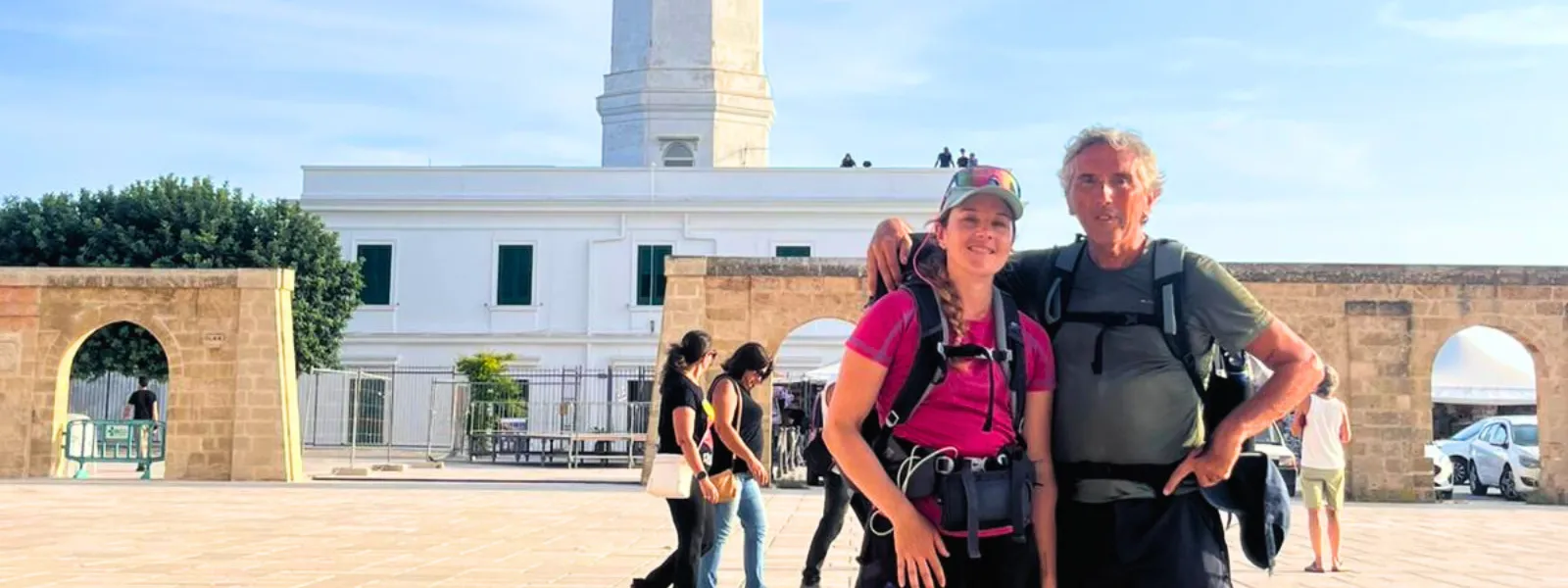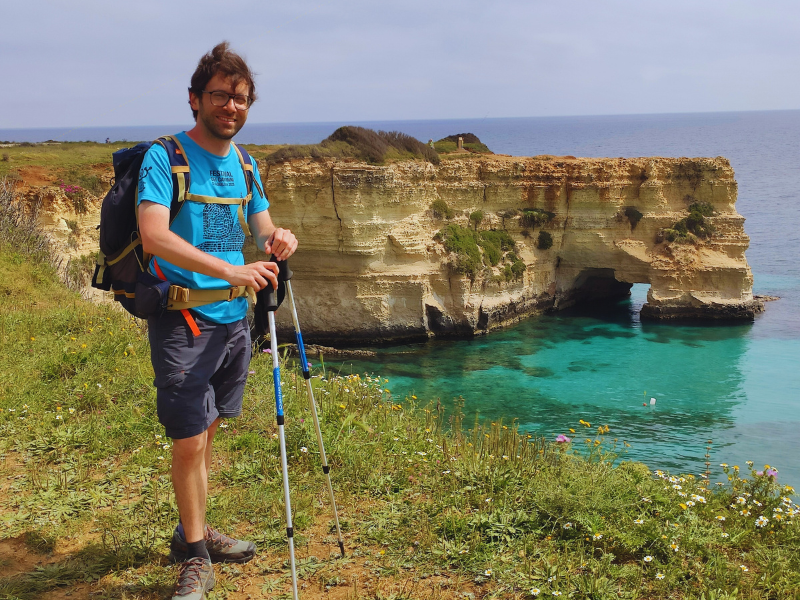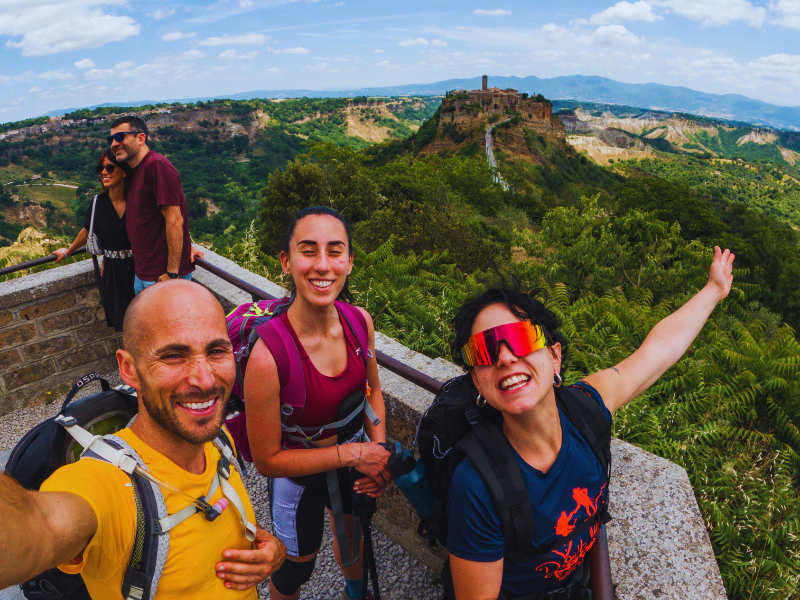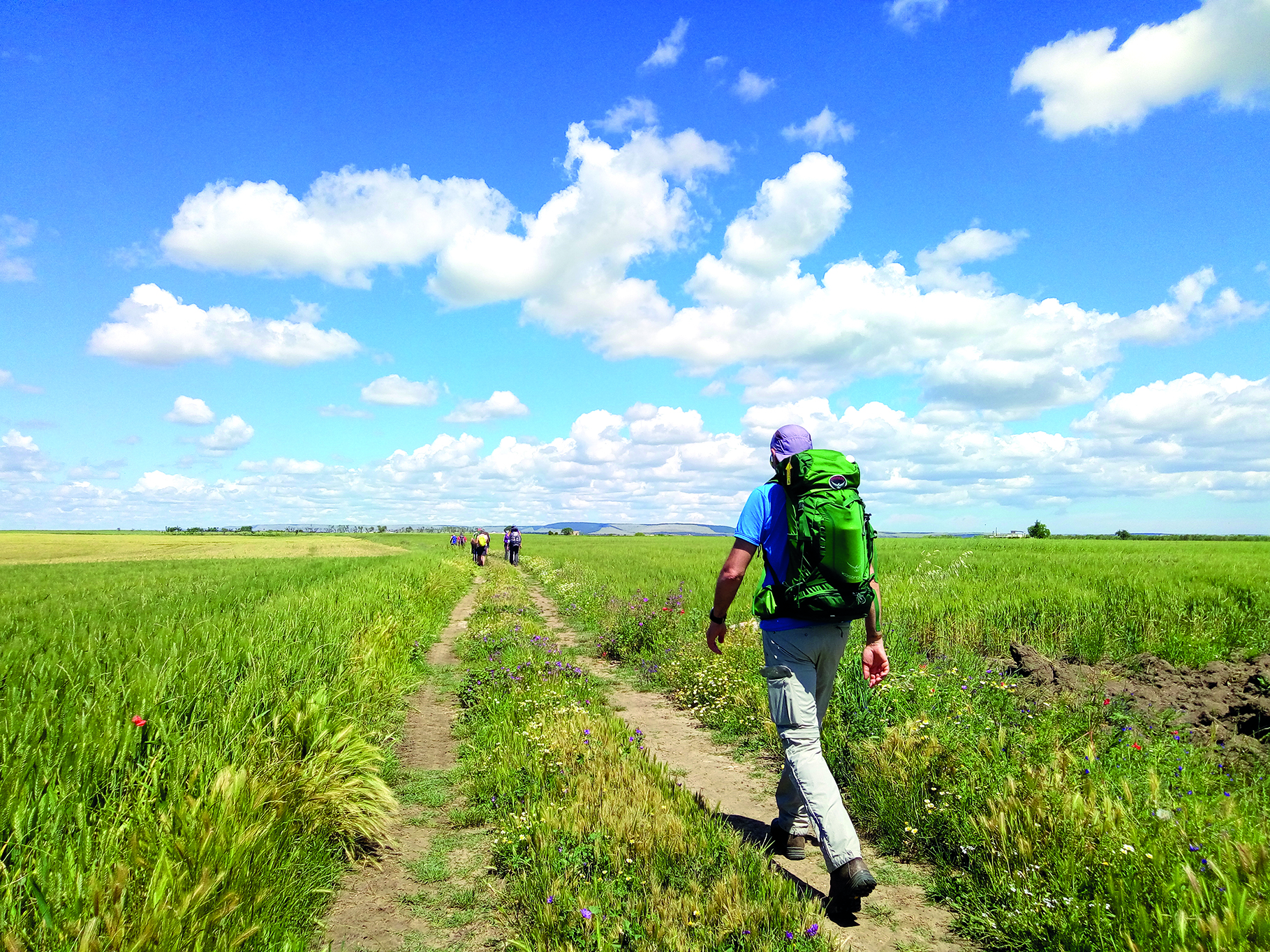Imagine being a father, and realizing the dream of sharing a path with your daughter. Because, that’s just how it is, there is something special about walks taken together, step by step, when time slows down and the landscape becomes a conversation and an opportunity to come together more and more. Roberto and Martina, two intrepid walkers, have chosen to walk the Cammino del Salento – Via dei Borghi, from Lecce to Santa Maria di Leuca, crossing countryside red with earth and olive groves marked by the wind, villages where in sunny piazzas the Salento pizzica resounds. Their diary has it all: the heat, the impromptu stops, the missing orange arrows, the figs picked along the way, the smiles of the people, the sea approaching stage after stage. A true and full of life tale, where Salento shows itself for what it is, that is, a land that welcomes, that tires and stays inside, but above all the sincere tale of an experience that goes beyond the destination: a familiar journey, made of fatigue, laughter and daily wonder. A journey that starts in Lecce and ends “Finibus Terrae,” but which in reality, like all journeys, does not really end.
Do you also feel like sharing your walking experience with our community? Email us at info@camminiditalia.org and we will send you all the information you need to tell your adventure. If you prefer, you can also join our Facebook Community and share your story directly there.
And if you want to make sure you don’t get lost along your route, remember to download the Cammini d’Italia app before you leave! With it you’ll have all the gpx tracks of many Italian walks at your disposal and you can navigate easily, even offline. Find out more at this link!
Introduction
For example, we like the south. Lecce, the starting point of the Salento Cammino di Dante, can be reached in several ways, car, train…we, my daughter Martina and I, chose the plane from Genoa to Brindisi. From Brindisi airport you can reach Lecce by a Cotrap bus, tickets can also be made on board as well as at the newsstand in the airport, which in about forty minutes arrives at the Lecce bus terminal in Piazza Carmelo Bene. This square is quite central and in a few minutes you can reach Porta Napoli, one of the gates leading into the city’s historic center.
We arrived in Lecce in mid-afternoon and reached our B&B to deposit our backpacks, waited until around 6 p.m., mostly because of the heat, and then went for a stroll through the historic center entering through Porta Rudiae, which leads directly into Via Giuseppe Libertini the main thoroughfare into the city and leads into Piazza Sant’Oronzo, the city’s heart.
The impact is absolutely positive, the typical light color of Salento stone dazzles and fascinates. Palaces, churches, small squares, many bars and restaurants, many stores, some characteristic others less so. On all the artisans working with papier-mâché and the pastry shops with the typical “pasticciotto” an authentic star of Salento. Time for an aperitif, a few tours to less touristy areas of the center and then to dinner for a first encounter with Salento cuisine.
The Salento path offers two options, the Way of the Sea is the Via dei Borghi which, after a different start, come together after three STAGES. We chose the Via dei Borghi seeking something less touristy and, in our opinion, the walk proved us right.
STAGE 01: Lecce – Sternatia
22 km
We set off in the morning very calmly, as per a travel philosophy we have given ourselves, after a pleasant breakfast at our B&B run by a fantastic lawyer whom we will meet again at the end of the walk. The backpacks, our traveling companions, are 40 liters and contain the necessities, perhaps something more, T-shirts and underwear, bathing suit, a light beach towel, a change of clothes for the evening, a light windproof jacket, flip-flops, “crabs” for bathing in the rocks, the necessities for the toilet, cables for the phone and a power bank, a health kit with providential band-aids, the water bottle.
Every walk starts with the backpack: discover our Guide to the First Walk, to start light but ready for anything.
Another travel companion is the pilgrim’s passport which we had previously requested from the promoters of the camino on their official website containing information about the route and especially spaces for the coveted stamps that attest to the destinations reached and also constitute a beautiful memento. Also from the promoters we also had GPX tracks that supplement the sometimes missing orange arrows.
That said, we set off. The walk begins at Porta Napoli, which we reach in a few minutes; after the customary photos, we cross Lecce, this time no longer as tourists but as walkers. Leaving the suburbs we finally reach the countryside and begin to become familiar with an environment that will accompany us for the next few days. Olive groves, unfortunately many with still signs of the Xylella that has raged far and wide but also many new plantings and other survivors. Predominantly red, stony soil. Dry stone walls everywhere and square-based, terraced trulli that we learned were typical of Salento and called pajare. Then blackberries and figs to refresh us on the way.
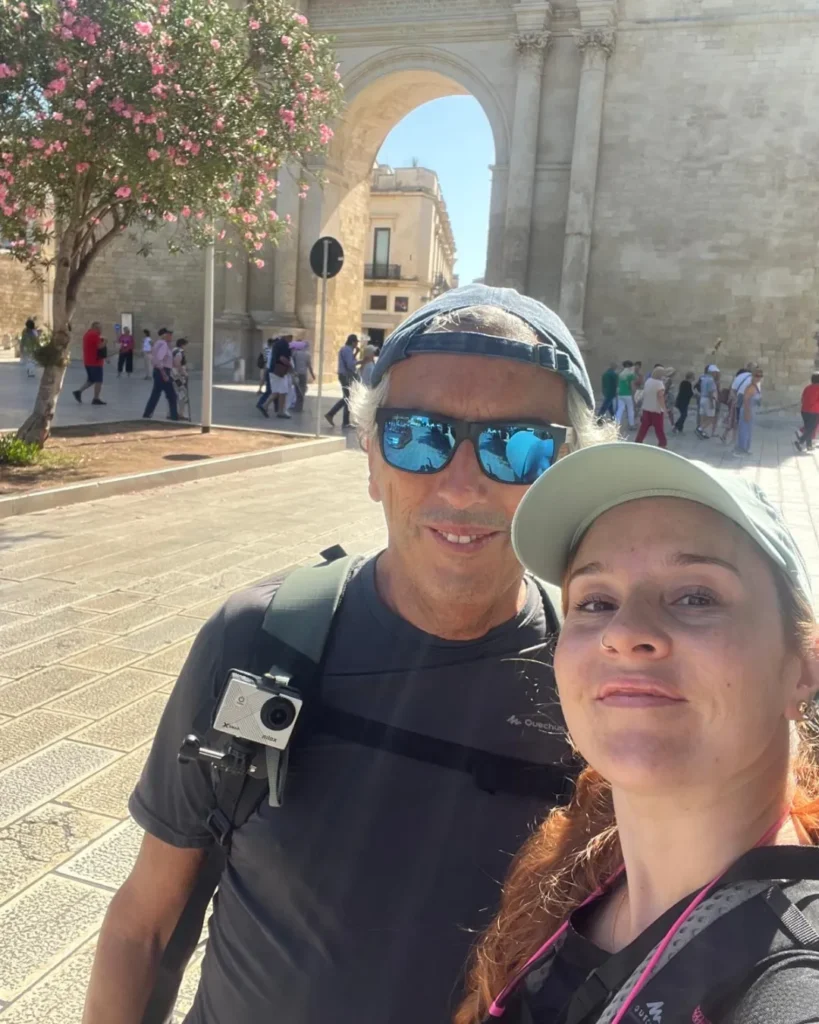
Lots of prickly pears a real splash of color everywhere. Hard in this context not to be reminded of Rino Gaetano’s song “Ad esempio a me piace il Sud,” which could very well be the soundtrack of our walk. The first town we encounter is San Cesario di Lecce, which confronts us with an urbanistic and architectural reality that we will find again throughout the journey, low houses, similar to each other, streets apparently all the same converging toward a center, generally consisting of a large square with important and ancient religious and civil buildings, all extremely oversized as evidence of an important past.
These features we will find more or less the same wherever we passed. But before we can get to the center we are faced with a first problem, the GPX tells us to cross the railroad at a level crossing but a wall has been built here and we have to look for an alternative that we find in an underpass a little further away. The first stamp after the one in Lecce we make in San Donato di Lecce where we stop for a snack.
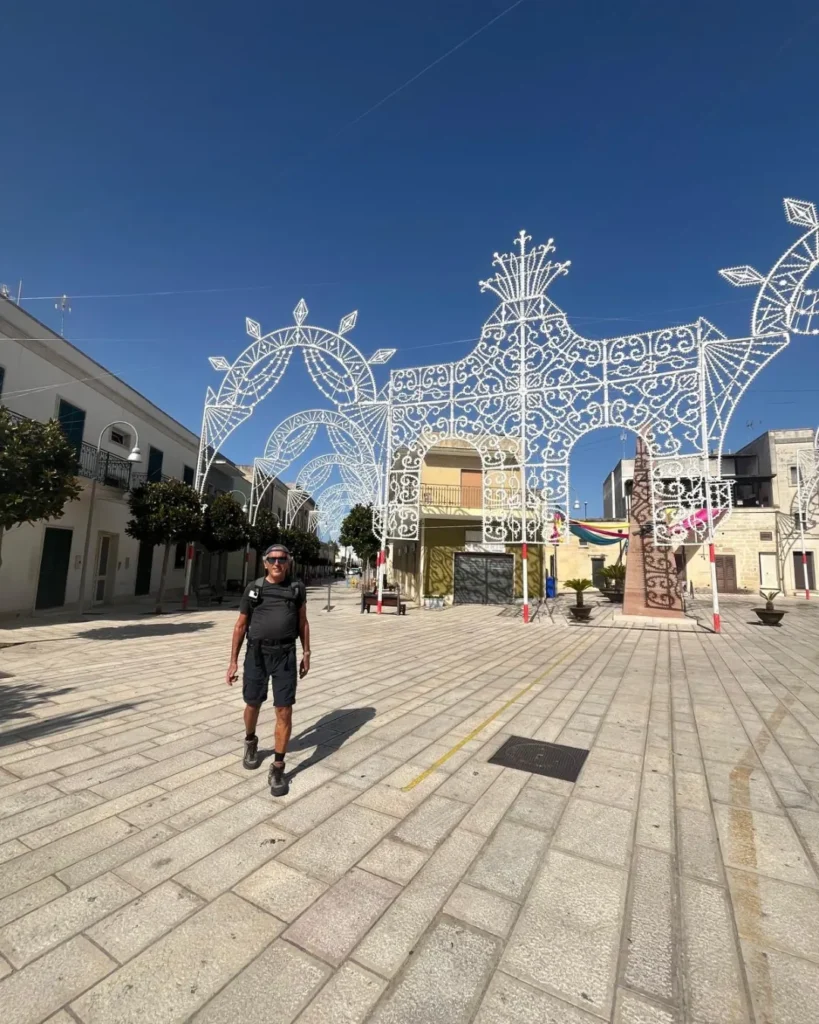
At this point there are about 7 kilometers to go, it is 2:30 p.m. and it is very hot. We start back toward Sternatìa our final destination for today and about halfway down we come to the small church Madonna della Neve, which has valuable frescoes of saints and saints from the 1400s in its oldest part. We arrive in Sternatìa around 6 p.m. and the lady at our B&B (another lawyer) welcomes us with fresh water, grapes and tarallucci-what more could you ask for? Sternatìa has a beautiful historic center full of noble palaces and churches here they speak Griko Salentino, a Greek-Italian language. In the evening we get our passports stamped and go to a pizzeria that will positively surprise us.
Stage 02: Sternatia – Corigliano d’Otranto.
20 km
We have breakfast in a café in the square of Sternatìa, always an interesting time to get closer to the social reality of villages, and leave, stopping immediately to visit the parish church of Santa Maria Assunta where the very kind parish priest gives us information about the village and its parishioners. We leave the historic center of Sternatìa by Porta Filìa, but before entering the countryside we buy postcards and stamps, items from another era but well suited for walkers, and we plan to write them again in the evening. After a while we walk through a flat and barren landscape, little vegetation, a few pajara, the railway line that we cross several times.
Almost immediately we arrive in Soleto and we take the opportunity to drink a “café leccese,” coffee on ice with almond syrup, an experience that the parish priest of Sternatia had recommended to us and that satisfies us. Between Soleto and Galatina we have our second setback, the orange arrows lead us to a barred road and the GPX does not recognize the places, so we walk on sight cutting through fields and after a few hundred meters we find the path again. After this setback we arrive in Galatina, “home of pasticciotto” the typical Salento dessert made of short pastry filled with custard but with many other variations in the filling, cream and black cherry, pistachio.
They come in different sizes and make a fine display in the windows of bars and pastry shops. We sat in a cafe in a bar in the square in front of the Basilica of St. Catherine of Alexandria, a facade that under the 1 o’clock sun is a joy to behold; here we also make our fourth stamp. The center of Galatina is bustling, tourists, locals, luminaries in honor of “Santu Paulu” who is invoked for protection from the bite of the taranta. Another coffee from Lecce and we are on our way again. We are 10 kilometers away from our STAGE destination.
There are many clouds in the sky today and the heat is tempered by a fairly strong wind. We travel several country roads through fields and olive groves and arrive at a large pine forest crossed by a wide dirt road, here we meet a kitten without a tail who follows us for a while to Martina’s delight. Leaving the pine forest, it is not long before we continue on a paved road that takes us to Corigliano d’Otranto. The first impression is the same as when we entered the other villages-low houses, similar to each other-and here too suddenly the view widens and we find ourselves in a tree-lined square with a large castle in the background.

It is the Castello de’ Monti, an example of the transition from medieval square towers to Renaissance round towers and how fortresses in the 16th century adapted to the arrival of gunpowder in wars. An imposing building surrounded by a deep moat, this is where we go for the stamp. It currently hosts art events under the name Flying Castle. From Piazza Castello through a narrow gate we enter the historic center and arrive at our very cozy B&B. We have dinner near Piazza Castello and here in my opinion we have our best dinner with Grika salad, fava beans and chicory, maritati with sausage, eggplant, tomato and arugula, meatballs with sauce, spumone and revisited torta sbrisolona made by the restaurant owner. All truly excellent. Especially the maritati, a typical wedding dish that combines together orecchiette and maccheroncini.
Stage 03: Corigliano d’Otranto – Otranto
27 km
Here again we have breakfast in the nearest cafe observing the very relaxed comings and goings of patrons, return to pick up our backpacks and set off for the third STAGE, a little worried about what will be a record length for our walk, almost 30 kilometers, final destination Otranto and the sea. The owner of the B&B who has just returned from the vegetable garden gives us two handfuls of the sweetest cherry tomatoes-this is Salento, too. We stuff our postcards and are on our way. After a little more than three kilometers we arrive in Melpigniano, another municipality in Salentinian Greece, a town famous for the extraction of the Lecce stone that characterizes Salento’s construction and for La Notte della Taranta, the concert that concludes the festival that travels through Salento’s towns.
It has just rained when we arrive in Melpignano and we arrive right on the large square of the former Augustinian Convent that traditionally hosts the event. The grass on the big lawn glistens laden with rain in the sun, large puddles reflect the facade of the former convent church. Not a single person around, this was the hallmark of these first three days of the walk, wonderfully empty villages, no other walkers. In this regard it must be said that the period we chose is not exactly the best, still too hot.
From September 15 onward the right and busiest time begins. Returning to Melpignano usual rigmarole of low houses that open onto a wonderful and huge square, everything is in Lecce stone and shines under the sun, here and several billboards recall the artists of past editions of the concert, in front of the town hall an original art installation reinterprets the road signs. The nasty surprise is that the bar that is supposed to stamp us is closed permanently and at the tourist information office, housed in a beautiful building formerly used for tobacco processing, the clerk is “out of the office” and will remain so for a long time, beyond our patience.

That empty space between stamps will be a vulnus in our spirit as walkers that only the splendor of the old town of Melpignano and a mural dedicated to the group CCCP have managed to heal. We set off on a road surrounded by quarries of Lecce stone and after a little less than four kilometers we are in Cursi, large square, large buildings, here we get our stamp at the bakery and take advantage of eating some pizzas. We continue through olive groves and at a certain point the road begins to climb slightly toward the sanctuary of Montevergine in the town of Palmariggi.
The shrine is nestled in a pine forest and is a place of great devotion for the surrounding villages and a destination for pilgrimages and country festivals. From the shrine one descends to Giurdignano on a badly paved and brushwood-invaded road that crosses a disused railway line with ghost stations. Giurdignano is known as the “megalithic garden of Italy” because it has a large concentration of menhirs and dolmens, and our walk encounters some of them, which we are unable to fully appreciate due to hunger and thirst.
Giurdignano is also the place for our eighth stamping, and, hungry and thirsty, around 2:30 p.m. we head for the bar in charge of stamping, but find that it will open no earlier than 3:30 p.m. as will the other bar in the village. Around just us and a couple of foreigners also looking for a drink. We are a little worried, as well as hungry and thirsty, because it is still more than seven kilometers to Otranto. We move from bar to bar under a blazing sun to see which one will open first, finally around 3:45 p.m. the stamp bar opens and miraculously fills immediately with patrons who seem to appear out of nowhere.
Finally after 4 p.m. we set off again refreshed. The road to Otranto is very beautiful, crossing the countryside along the Idro valley. Here we encounter the crypt of Sant’Angelo, a rock church in which remains of frescoes are still visible, also all around remain caves presumably inhabited around the year 1000. The final part of the walk flanks the Idro River and takes us directly into the center of Otranto.
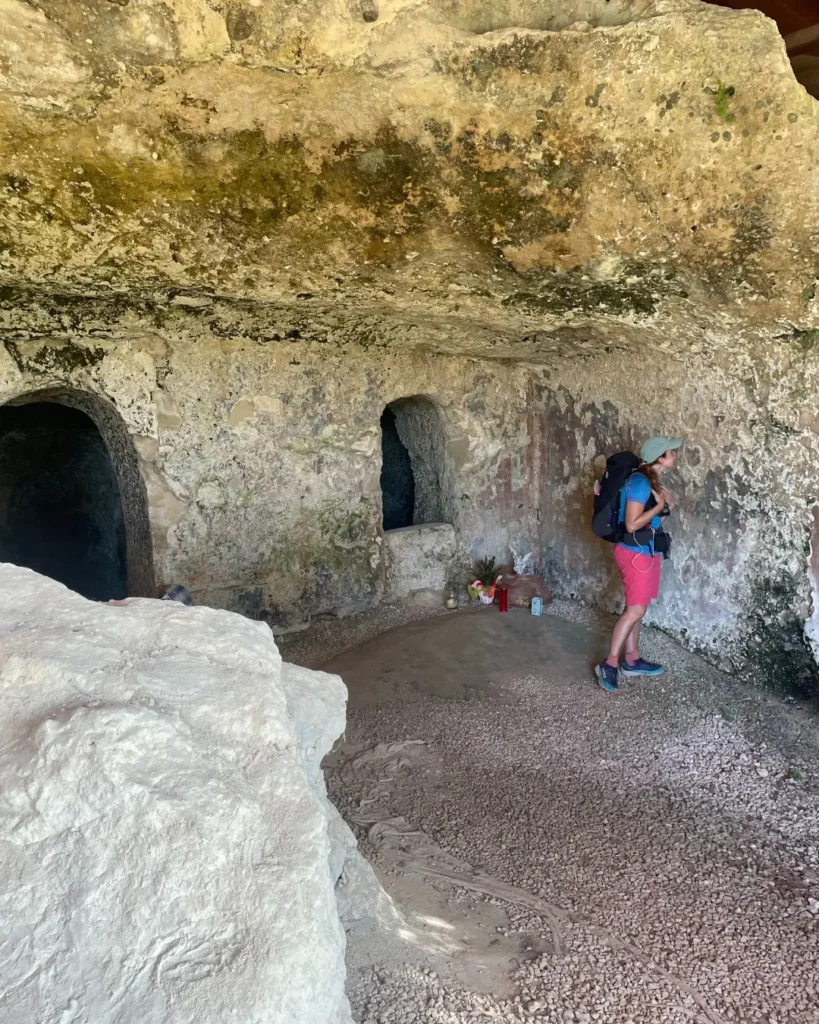
Here the impact with this new reality is devastating, after three days lost in nothingness we find ourselves immersed in the vacationers who crowd the city. We need some time to adjust and we will do so not without regret. Our B&B is strategically located in the historic center near the belvedere of the ramparts. Dinner in Otranto without infamy or praise, too many tourist places little real tradition. One observation regarding the time of dinner, while in the interior it was difficult to dine before 8:30 pm here in Otranto, due to tourist requirements restaurants are already full at 7:30 pm.
Right in Otranto the Via dei Borghi rejoins the Via del Mare. Do you want to discover this route? Read here Laura’s blog diary!
STAGE 04: Otranto – Santa Cesarea Terme
22 km
As lively as the city was in the evening as it is deserted this Friday morning at nine o’clock, the strong wind sweeping the Adriatic forced a large three-masted cruiser to take shelter in the harbor. We have breakfast in one of the many cafes and then take advantage of the calm to take a tour of the historic center, which is really quaint and in particular we visit the Cathedral of Santa Maria Annunziata with its fantastic mosaic floor, executed between 1163 and 1165, which covers the entire surface of the church with scenes from medieval bestiaries, the Old Testament and the life of Alexander the Great. The crypt is also notable.
Before we set out, we go to the castle for passport stamping. The path of the Via dei Borghi in Otranto reunites with the Via del Mare and descends to the harbor flanking the coast in a southerly direction, the landscape is rocky and barren and turning back we have a beautiful view of Otranto. The path takes us to the elevated Torre della Serpe and then back down to the coast where ravines and caves alternate. Before long, after crossing a plain covered with shrubs and close to the sea we arrive in Orte Bay, already crowded with tourists, where in a beautiful glamping we make our stamp and drink an excellent Lecce coffee.
Soon after, the trail climbs to the Bauxite Quarry, a very scenic place with a pond between red sloping banks and pine trees. Very photographed place and quite crowded. The walk continues rather far from the coast, but the sea seen from above is a spectacle. The vegetation and typically Mediterranean unfortunately at one point defaced by a relatively recent fire. The smell of burning is in the air, but among the burning brushwood new shoots are already sprouting lushly. We catch a glimpse of the Punta Palascia Lighthouse in the distance and with a further surge the path reaches the provincial road and flanks it for a stretch. Near the lighthouse, as if in a mirage, a van materializes with the imaginative name of “The Wandering Coffee Maker,” and we cannot avoid making a stop.

From here on, the path passes through highly evocative places, climbing inland to pass Capo d’Otranto and circling around it in an impervious and rocky landscape with a steep descent back to the sea, on the right the ruins of the Tower of Sant’Emiliano and on the left the entrance to Grotta della Macchia. Having reached the flat, one continues along the sea towards Porto Badisco, located about 15 kilometers from the departure from Otranto. In this stretch, if the weather is favorable, as in our case, it is advisable to take a dip, taking advantage of the less impervious rocky areas. Porto Badisco is an absolutely beautiful place but we get there on Friday, September 5, and it feels like Rimini, bathers everywhere both in the water and on land. We stretch our pace toward the grocery store that will do our stamping for us.
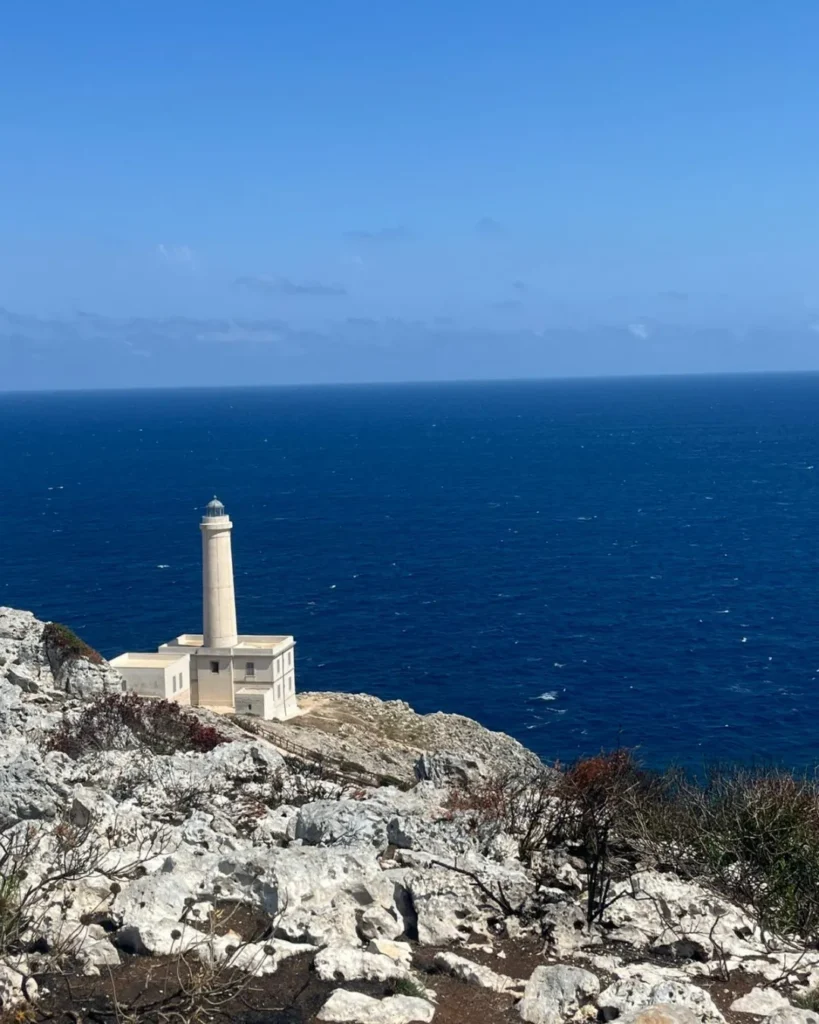
We eat something, fill our canteens, and leave almost immediately. As you may have guessed, we are not overly sociable people. The route continues for a stretch on a sunny uphill provincial road and then turns back to the left into the countryside; it is three o’clock in the afternoon and very hot. After a long while ahead of us we see another pair of walkers and almost in competition we get on their trail, but when we have almost caught up with them we realize that they have led us off the road. We consult the GPX and turn back. We go up the other side of the hill and here we actually face four walkers who we later find out are from Cortina.
The path continues through parched and stony countryside at high altitude. Two kilometers from the daily destination, Santa Cesarea Terme, the path turns in on itself and descends rapidly through even a steep flight of steps toward the sea. We enter Santa Cesarea Terme and at the beginning of the town we find the bar for stamping. Santa Cesarea, as the name implies is an elegant spa town with large buildings and hotels, ours unfortunately is on the opposite side of the town and at the top of a steep slope that gives us the runaround for that day. Fortunately for dinner we find a restaurant very close by and even more fortunately tomorrow’s route passes right through there.
STAGE 05: Santa Cesarea Terme – Marina Serra
23 km
Breakfast at the hotel and departure. The path in its first section takes us uphill on provincial road SP358 and before the disconnection makes us bend left toward Castro. We cross the classic Salento countryside that we have come to know and after 6 kilometers we arrive in Castro, a village perched on a promontory that immediately fascinates us. A beautiful square with a fantastic belvedere surrounded by historic buildings including the Aragonese Castle and the ancient Messapian Walls. At a bar in the square we make our stamp, fill our water bottles, it continues to get very hot, and drink a coffee from Lecce.
The village is lively and welcoming enough that we struggle to get back on the road. Now we descend through the narrow streets of the village toward Castro Marina, the ancient Castrum Minerve for the Romans, where Virgil had landed Aeneas. The lower town is much more holiday-like but still very glamorous, from here begins a coastal path among the rocks of about 2 kilometers that is quite challenging and offers excellent opportunities for swimming. We arrive at Cala dell’Acqua Viva, it is Saturday and full of bathers, some of whom we have to literally climb over to reach a kiosk and have lunch.
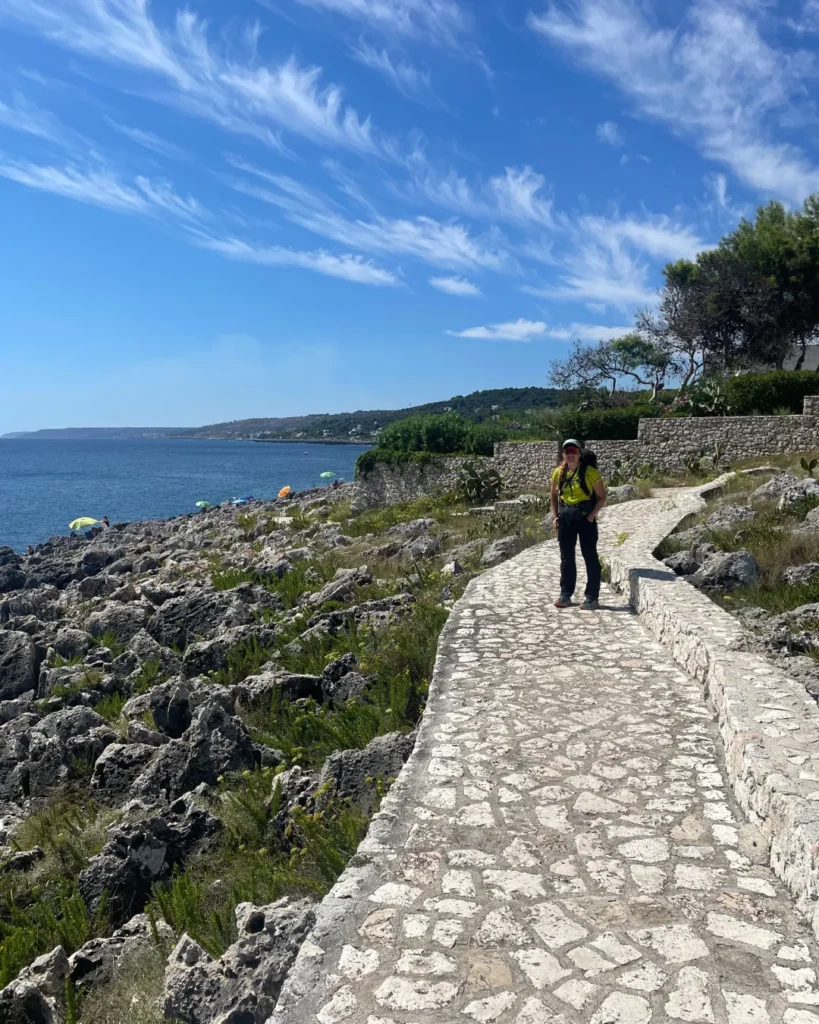
From Cala dell’Acqua Viva we keep going up towards SP358 and after a short stretch we bend right inland for a rather steep and bumpy climb, the next 10 kilometers will be all in the middle of the countryside, even with some fear for our water reserves. Usual landscape, olive trees, pajare, sections incinerated by the fire given to clear the brambles, fig trees, even a few bunches of grapes. After these ten kilometers that seemed interminable we arrive at Tricase Porto and reencounter some civilization, quench our thirst, stamp in a grocery store and get back on the road, about 3 kilometers to our destination.
We go around the promontory from the inside and this presupposes other rather challenging uphill stretches, especially at the end of the day, and then we finally descend to Marina Serra, a very small but very beautiful village with beautiful natural pools, few houses, few restaurants or pizzerias, two, only one hotel ours. Our hotel deserves a special mention because in addition to being in a great location by the sea it is cozy and the owners are so nice that they make themselves available to go to the pharmacy for us in Tricase. We have a very good dinner at the hotel and catch up with the four walkers from Cortina with whom we inevitably exchange travel opinions. A little stroll around the village in the evening after dinner further accentuates the positive opinion we had had on first impact.
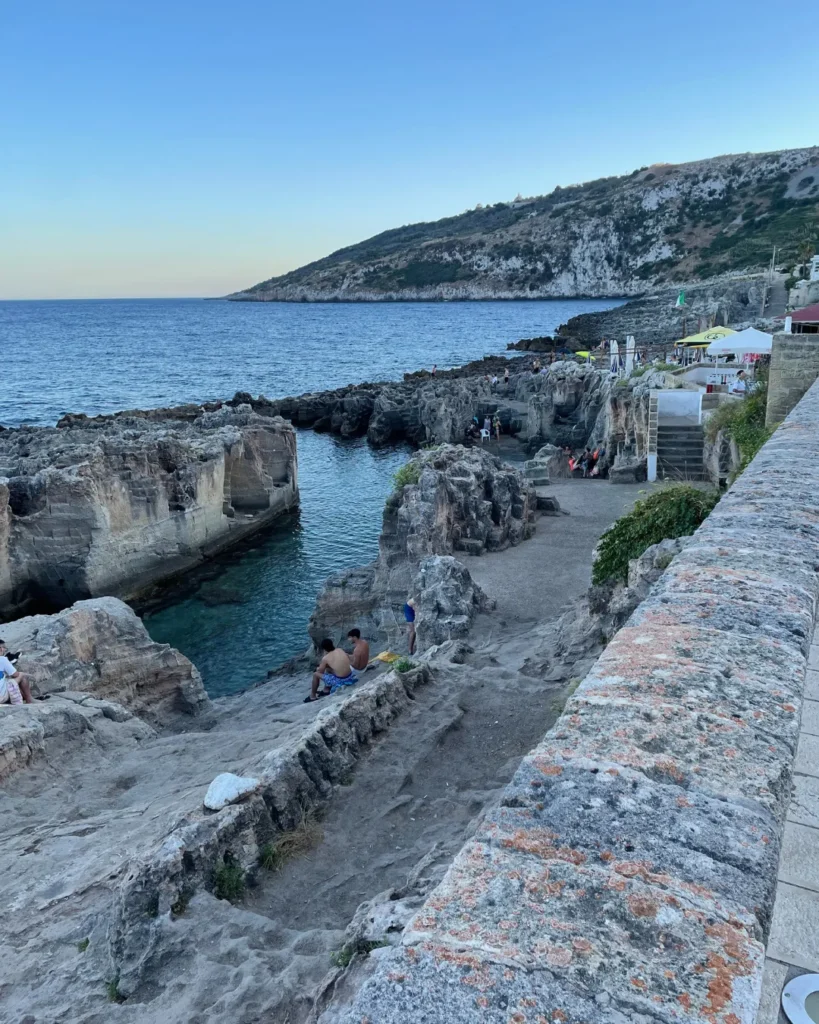
STAGE 06: Marina Serra – Santa Maria di Leuca
22 km
Breakfast at the hotel and on our way for the 22 kilometers of the last STAGE that will take us to Leuca. We start immediately uphill towards the hinterland and reach after almost four kilometers Tiggiano, the place of our first daily stamp, today we will even have four. The pleasant surprise is that in Tiggiano we get our stamp from an artisanal pastry workshop, totally unexpected and unpredictable. We remain admired by both the assortment and the location as well as the prices, which are absolutely low; we taste the classic and fig mostaccioli and take note of their website for future orders.
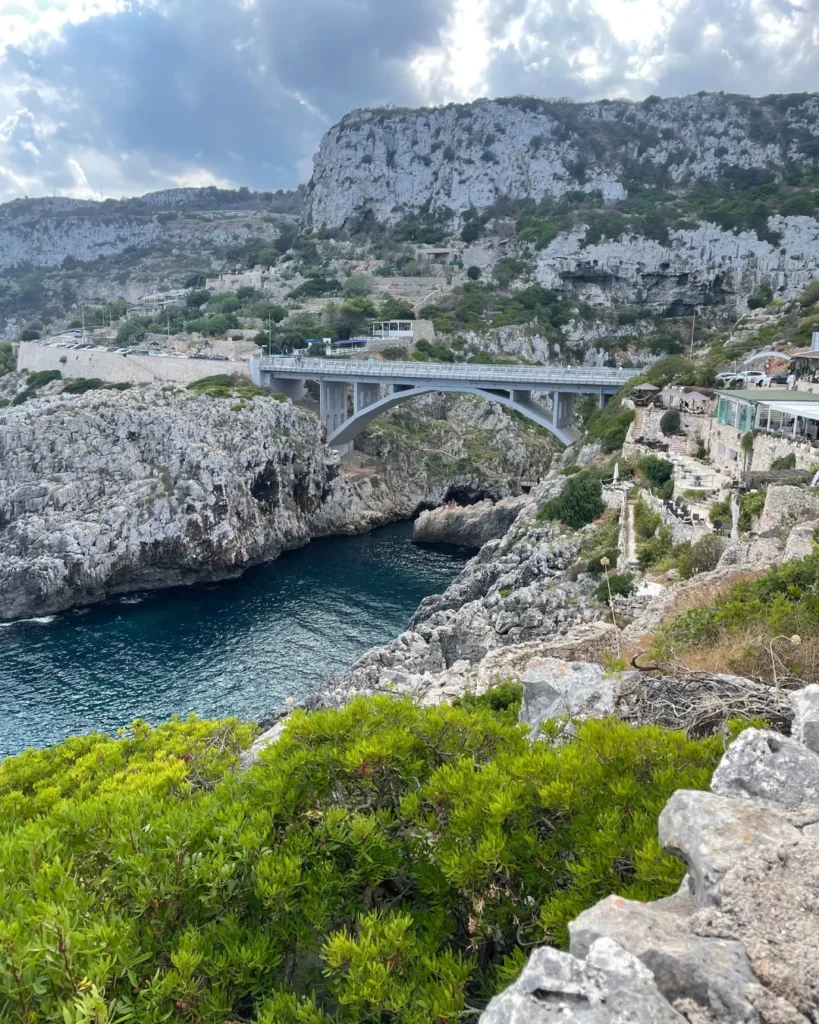
After a few kilometers we are in Corsano and in the bar in front of the schools we get our stamp and have a coffee. The path continues through olive groves and fields of red earth with the ever-present pajare, some restored others almost abandoned, but all very scenic. The road then bends toward the sea to reach Marina di Novaglie with a beautiful natural pool. It is Sunday and contrary to the usual we treat ourselves to a stop at an air-conditioned restaurant by the sea, after all we have earned it, we think. From here begins a path called the Cipolliane because of the caves of the same name.
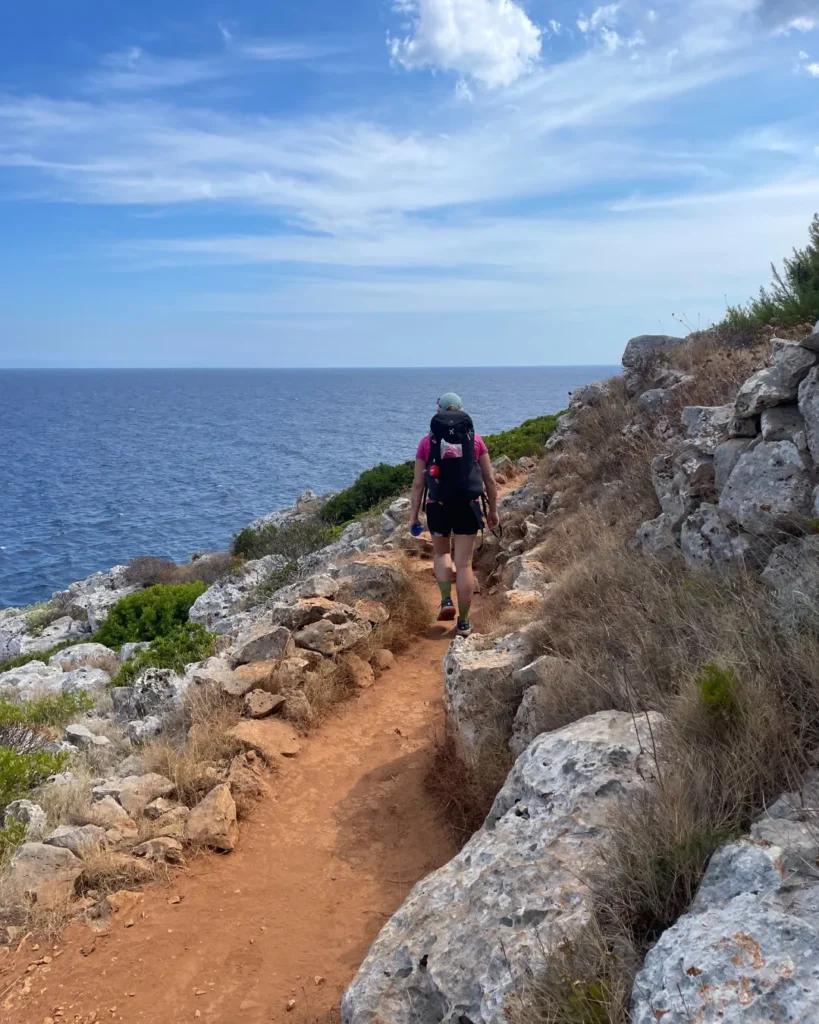
A very picturesque path carved into the rocks follows the route of ancient sheep-tracks bordered by low walls. Once all cultivated with olive trees now the surrounding terraced area is invaded by Mediterranean scrub and prickly pears. Still remaining as a reminder of the ancient cultivations are the “mantagnate” high dry stone walls to counteract the sea wind, ever present here. In this unique landscape, with the waves crashing on the cliffs, we continue on to Ciolo Bay.
Ciolo is a tourist attraction with restaurants and bars, we get our stamp and cross the bridge that crosses the bay connecting two opposite sides, very picturesque. Immediately after the bridge a steep path begins flanking some rock gyms where we see numerous climbers engaged and, still climbing relentlessly, we arrive in Gagliano del Capo, now just under 8 kilometers away from our final destination. We are again in open country and continue through the usual landscape. Around the 20th kilometer of the day, when there are two more to go to Santa Maria di Leuca, we arrive at the so-called Erma Antica, the place where pilgrims symbolically deposit a stone.
We cannot help but do so and to immortalize it with our cell phones. The final two kilometers seem interminable, we finally arrive in Santa Maria di Leuca and laboriously make our way to the Sanctuary of Santa Maria de Finibus Terrae and as expected, but unconsciously removed, we are confronted with the long and steep staircase that rises from the port to the sanctuary. Steps that originated around a waterfall made to celebrate the construction of the Apulian Aqueduct but now melancholically dry. With one last effort and a few pauses we are at the top, we look around satisfied, it was just as we expected. We make the final stamp and have our picture taken in front of the shrine and the lighthouse. Mission accomplished. With some heaviness we head for the hotel, which fortunately is not too far and not too far uphill either. We have dinner at an original restaurant that also merges a bar and the sailing school. We already buy tickets for tomorrow’s bus to Lecce.
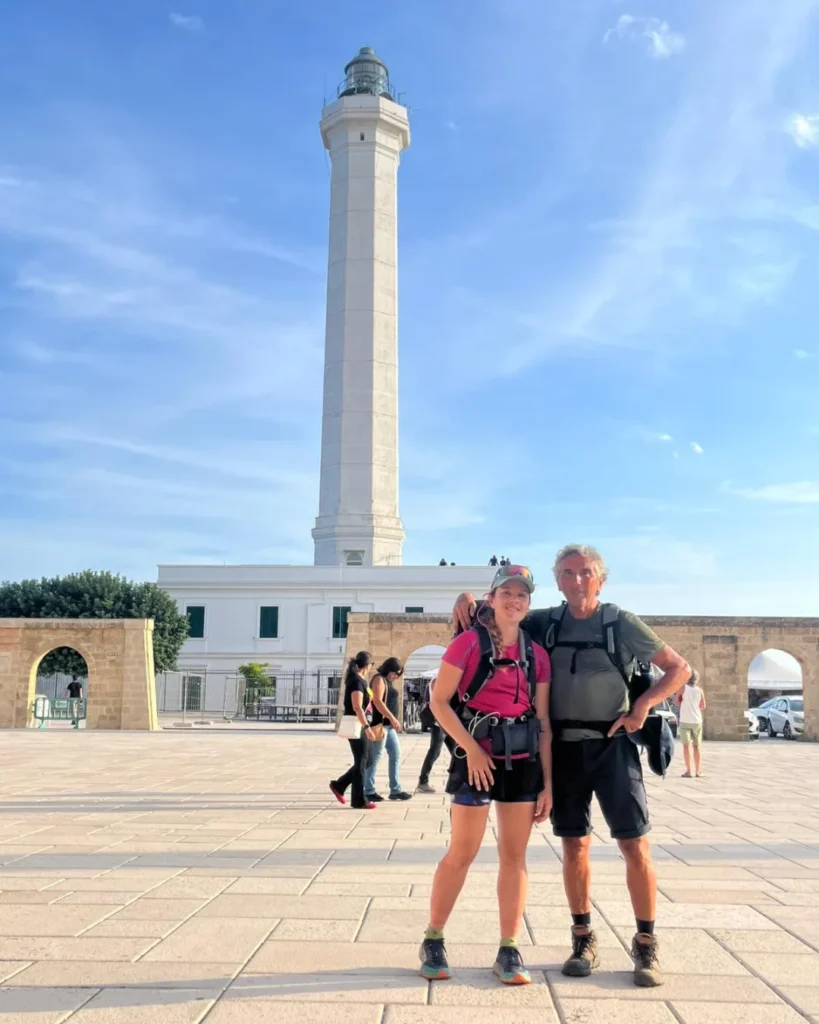
The homecoming
Santa Maria di Leuca is a coastal town with a beautiful seafront promenade and numerous villas built here by the Salento aristocracy beginning in the second half of the 19th century. They are villas that compete with each other with their heterogeneous style, classical, extravagant, Gothic, Moorish, Pompeian signed by the major architects of the time and each of them on the beach has its “bagnarola,” large brick cabins that in style recall the villa of reference. We have a bus to Lecce at thirteen o’clock from the Piazzale delle Terrazze and take advantage of the missing time for a little relaxation on the beach and a bath.
The bus takes about two hours to get to Lecce via Gallipoli and passing through pleasant scenery, leaving us in Lecce in front of Porta Rudiae, not far from our B&B, the same as the first day. We spend the afternoon walking around Lecce doing a minimum of shopping aimed at gifts to take home. Then last dinner in Lecce before our return, which will be in the early afternoon of the next day.
Good experience, relatively easy trail but requiring a minimum of training over distances around and over 20 kilometers. Although we had broken-in shoes there was no shortage, in my case, of toe problems and thus quality patches galore. The ideal time starts after September 15/20, we left on September 1 and it was still very hot although there was never a lack of wind to mitigate the temperature. As mentioned we enjoyed the Via dei Borghi that connected us with a truer Salento. Needed GPX because the orange arrows on the route were not always detectable. Good advance planning regarding accommodation is essential. Last advice take it easy, don’t live it as a competition, savor the moments that Salento can offer.
